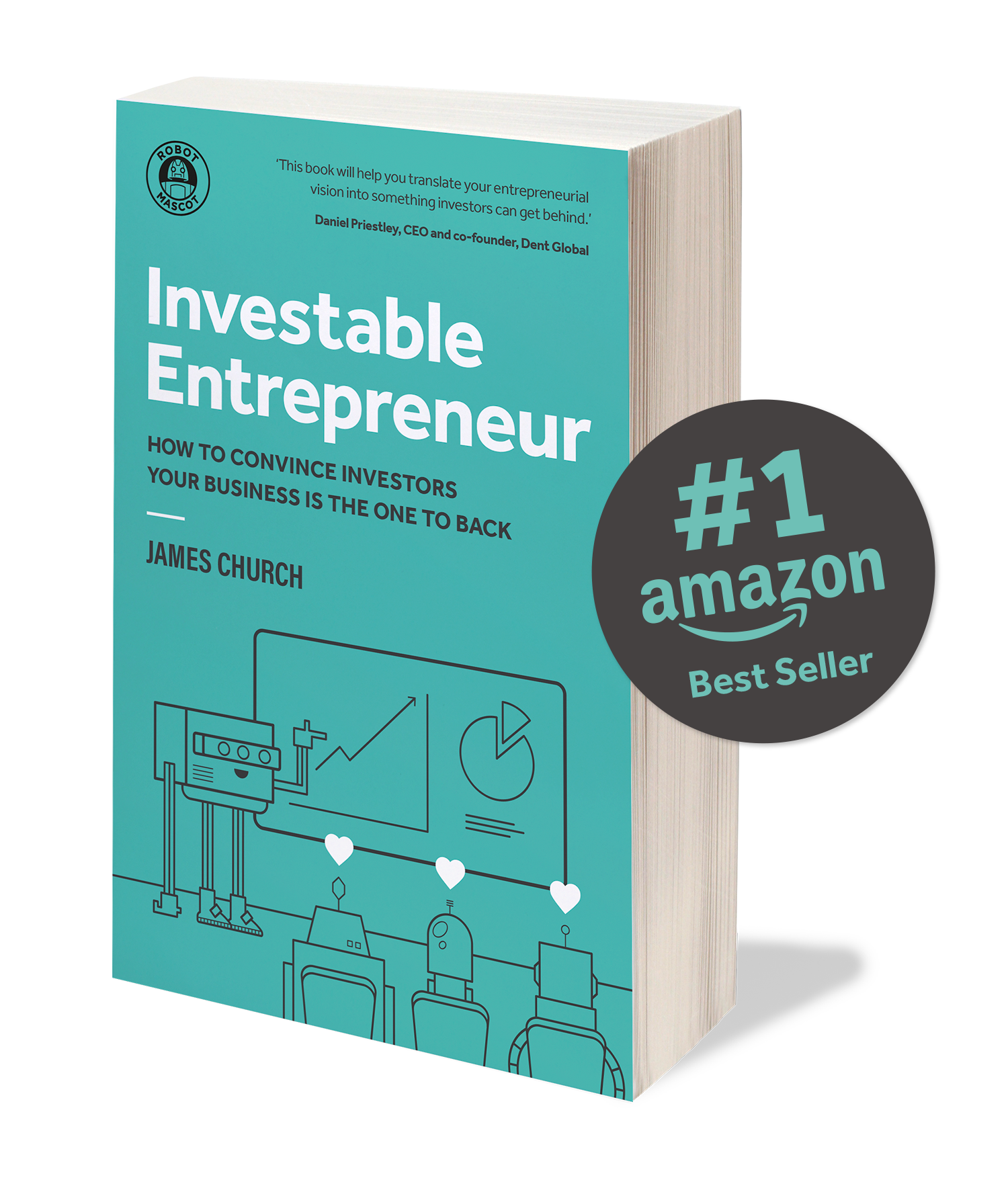

How To Overcome Presentation Anxiety When Pitching
30th March 2023
Very few people can stand up in front of strangers to ask for a large amount of money without a few nerves. While nerves are to be expected – you run a business, you’re not a professional performer – anxiety shouldn’t stop you from presenting your winning business confidently or stop you from securing investment. There are lots of things you can work on to help reduce anxiety and nerves when you’re pitching and presenting and this article will arm you with the knowledge, skills and mindset you need to calmly and confidently deliver your presentation.
Jump to the following sections:
The causes of presentation anxiety
Presentation anxiety – also known as public speaking anxiety – is a common experience for many people. There are several reasons why people experience anxiety when presenting, including fear of judgement, fear of failure and performance pressure.
The fear of judgement is a common cause of presentation anxiety. People worry about being judged by their peers or superiors and this can lead to feelings of self-doubt and nervousness. This is particularly true when presenting to a large group of people who are unfamiliar or when the stakes are high.
Fear of failure is another common cause of presentation anxiety. People worry about not being able to deliver a great presentation, making mistakes, or forgetting important information. This can lead to feelings of nervousness and stress, which can in turn affect the quality of the presentation.
Performance pressure is also a significant contributor to presentation anxiety. People feel pressure to deliver a great presentation, especially when there are high stakes involved. This pressure can lead to feelings of nervousness, stress and self-doubt, which can impact the quality of the presentation.
Presentation anxiety is a common experience and it is important to understand its causes to develop strategies to manage it so that you can give confident and engaging presentations.
Preparing for your pitch
If you suffer from presentation anxiety, it’s important to take steps to prepare for your pitch in a way that minimises your stress and maximises your confidence.
Here are some tips to help you prepare for a pitch presentation:
Practise
Rehearse your presentation multiple times until you are confident in your delivery. This will help you become more comfortable with the material and reduce anxiety. If possible, deliver the presentation to people you know, two or more at a time, to help you get used to ‘having an audience’.
Know your audience
Understanding the people you will be presenting to can help you tailor your message and reduce anxiety. Research them on LinkedIn or their website to find out a little about them. Make them human in your mind – they’re just flesh and bone like you.
Prepare backup materials
Have backup slides or props to use in case you forget something or if there is a technical issue. Some people even prepare a complete script so that if they get lost they know they can just read the script. While reading isn’t ideal, it usually means that the fact the person has the script helps them be more confident and not need it.
Get a good night’s sleep
Make sure you are well-rested and have enough energy to present effectively. It may sound obvious, but don’t drink alcohol the night before, don’t drink caffeine after dinner or do exercise before bed.
Visualise success
Visualise yourself giving a successful presentation to reduce anxiety. Imagine yourself at your best, standing up in front of those nice people who are listening and smiling as you clearly deliver your presentation. Imagine it blow by blow: you arrive, you welcome them, you thank them for their time, there’s a bit of a glitch with the computer but it’s quickly solved, your audience laughs along with you, they’re on your side, you work your way through your slide, they’re interested, they ask questions, you answer them, you finish, they smile and thank you.
Managing anxiety on the day
When it comes to managing anxiety in the moment, there are several techniques you can use to calm your nerves and improve your focus.
Here are some tips:
Before you start
Deep breathing exercises
Practise deep breathing exercises before your presentation to calm your nerves and improve your focus. Exercises such as diaphragmatic breathing, belly breathing or alternate nostril breathing to calm your mind and body. Breathing exercises are a great way of controlling your body as it will respond to the way it’s breathing. By breathing deeply and slowly you can calm your nerves and bring your body back from spiralling into a panic.
Visualisation techniques
If you’re feeling nervous before you start, try positive visualisation. See above.
Positive self-talk
Use positive affirmations to boost your confidence and calm your nerves. Repeat positive statements to yourself such as “I am capable and confident” or “I have prepared well and I can do this.”
Grounding techniques
If you feel overwhelmed, try to ground yourself in the present moment by focusing on your physical sensations or the things you can see, hear, touch, smell or taste around you.
During your presentation
For many people, the waiting is worse than the doing and once you get going: nerves subside and the adrenaline helps you focus and think. If however, you feel anxiety welling up during your presentation, try the following.
Your audience
Remember that your audience is just some people doing their job, just like you’re doing yours. They’re not expecting a TED Talk, they know you’re not a professional keynote speaker and they’re on your side.
Breathe
What often happens is this: your adrenaline starts flowing which makes your heart pump faster which in turn means you breathe more quickly, which makes you out of breath when you’re trying to talk. Take a second to steady your breathing, this will help calm you in the moment. Your audience is patient and understands what you’re going through. Take a few calming breaths and resume. One tactic to buy a minute to breathe is to ask a question to your audience. Or you can just say, ‘give me a second’ – remember, they understand.
Focus on the message
Remember that you are there to deliver a message, not to perform. Stop thinking about the presentation and how you’re being perceived and focus on the content of your presentation and what you want to achieve.
Be yourself
Remember that the investors want to hear from you and understand the unique insights that led to your brilliant business idea. Don’t try to be someone you’re not. They will know that you’re nervous and you can be honest about that.
Body language
Maintain good posture, make eye contact and smile to give yourself an air of confidence. It may sound like a small thing, but it can have a powerful effect on the way you feel.
Take a break
If you really need to, ask to take a three-minute break. Do some breathing exercises to bring your heart rate down. You might choose to speak to your audience during that time. This can help build familiarity between yourself and the audience before you resume.
By incorporating these techniques into your pre-presentation routine and using them in the moment, you can effectively manage anxiety and give a confident and successful pitch.
Building confidence and self-esteem
Building confidence and self-esteem is key to overcoming anxiety when it comes to presentations. Here are some ways to achieve this:
Set realistic goals
Setting achievable goals can help you feel more confident and in control. Break down your presentation into smaller, manageable tasks and focus on one at a time.
Focus on your strengths
Think about your unique skills, abilities and knowledge, and highlight them in your presentation. Emphasise your strengths and the value you bring to the table.
Develop a positive attitude
A positive attitude is crucial for building confidence. Surround yourself with supportive people and focus on the positive aspects of your presentation, rather than the negative.
Practice self-care
Taking care of your physical, emotional and mental well-being will help you feel more confident and in control. Engage in activities that make you happy and reduce stress, such as exercise, meditation, or hobbies.
Get feedback and learn from mistakes
Ask for constructive feedback from people you trust and use it to improve your presentation skills. Remember that mistakes are opportunities to learn and grow.
Build resilience
Resilience is the ability to bounce back from challenges and setbacks. By practising the elements above, you can build resilience by embracing challenges, seeking support when needed and learning from failures.
Use technology effectively
Using technology effectively during a pitch can help alleviate some of the anxiety that comes with presenting – knowing that it’s not all on you and that your slides or props can do some of the heavy lifting. Here are some tips on how to use technology to your advantage:
Utilise visual aids
Visual aids such as slides and graphics can help you keep the audience engaged and on track, and make your presentation more professional.
Rehearse with technology
Practice using the technology you will be using during the presentation, such as projectors and sound systems, to get comfortable and confident with it.
Keep it simple
Avoid overloading your slides with too much information or using too many special effects. Stick to simple, clean designs that help get your message across effectively.
Use remote presentations
If you are delivering a virtual presentation, take advantage of tools like screen sharing, virtual backgrounds and video conferencing to create a professional and engaging experience.
Use props
If you are nervous about speaking, consider using props such as a physical model or demonstrations to help illustrate your points. By allowing people a moment to look at your product or prop you can just settle your nerves and breathe.
Keep backup options
Ensure that you have backup options in case technology fails, such as having a printed copy of your slides or an offline version of your presentation.
By using technology effectively, you can help reduce anxiety and make your presentation more engaging and effective. Remember to keep it simple and focus on delivering your message clearly and confidently.
Understand your audience
Humans fear the unknown. As such, not knowing who you will be presenting to can make us nervous. Find out a bit about your audience before or in the room to reduce nerves:
Research
Find out a bit about their background, interests and needs to tailor your presentation to them. You might even say something that you’ve found out about them before you start to break the ice.
Identify common ground
Look for common interests, goals, or challenges to build rapport and establish a connection with the audience.
Adapt your style
Consider the audience’s preferences for language, visual aids and pace to make your presentation engaging and accessible.
Ask questions
Reach out to those watching your presentation to learn more about the audience’s expectations and preferences.
The presentation
Prepare a knock-em-dead presentation that you are confident will wow investors. Having this will help to reduce anxiety.
It just so happens that we can help you with this:
READ: Five ways to make your pitch deck stand out from the crowd
READ: What to include in your pitch deck
READ: Fundraising campaign: do the six principles of the perfect pitch really work?
READ: How and why a great pitch deck design can win over the support of even the most reluctant investor
READ: How to write compelling pitch deck content that engages investors
Rehearsing and practising
This is obvious. But why? And how does practising help to reduce presentation anxiety?
Improves confidence
Rehearsing gives you the opportunity to identify and address potential challenges in your presentation, which can help increase your confidence and reduce nervousness.
Increases familiarity
The more you rehearse, the more familiar you become with the content of your presentation and the more comfortable you feel presenting it.
Refines delivery
Rehearsing allows you to practise your delivery style and tone, so you can present in a confident and engaging manner.
Identifies areas for improvement
By rehearsing, you can identify areas in your presentation that may need improvement, such as unclear messaging or awkward transitions.
Builds muscle memory
Rehearsing helps establish a sense of comfort and familiarity with the presentation, reducing the likelihood of forgetting important points or stumbling over words.
If you’re pitching for funding, why not download a free copy of our bestselling book Investable Entrepreneur. It’s full of great advice for founders and entrepreneurs – including tips and guidance for those seeking to secure funding.
Learn how to convince investors
Investable Entrepreneur takes you through our winning methodology – the process we use to increase our client’s chances of raising investment by more than 30x.
“This book will help you translate your entrepreneurial vision into something investors can get behind.”
Daniel Priestley, CEO and founder, Dent Global and four times best-selling business author

Keep up to date with what we’re up to via email






Copyright ©Robot Mascot Ltd. All rights reserved.









